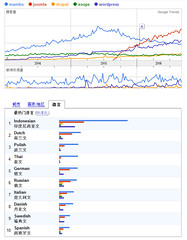
- Image by ♥ China ♥ guccio via Flickr
2009 Trends in Content Management
By Martin Jacobs, Vice President of Technology and Matthew Johnson, Senior Technical Architect Razorfish CMS Center of Excellence http://www.razorfish.comThe world of content management is ever changing in the digital world, especially in enterprise scenarios. To start off, we at razorfish though we’d look at some important trends in 2009 that are sure to make for an exciting year in content management.
Move from decoupled to coupled
One key element around CMS is whether to leverage a decoupled CMS (e.g. Interwoven, Documentum) vs a tightly coupled CMS (such as Tridion, SiteCore and Vignette). In the last couple of years, we have seen a stronger trend towards more tightly coupled CMS. A couple reason for this exist:
Personalization and targeting is becoming a standard requirement for many web sites. As a result, instead of a page centric model, a more component / module centric model is more applicable. This requires a different delivery model, as well as a different administration view.
- Social capabilities are becoming an integral aspect of the overall content management ecosystem.
- In-context editing is a key requirement to support a component view of content. In addition, in-context editing is crucial to increase adoption.
As a result, vendors like Interwoven have developed additional modules that provide dynamic editing and delivery capabilities such as LiveSite and Targeting to address the market place needs.
The CMS becomes social
The focus of traditional CMS software packages has primarily been content. However, the social use of a CMS has grown in importance. It is not just about content, a CMS is starting to play an important role around communication, conversation and collaboration. All these elements need to be tightly integrated with the content itself.
This place a more important emphasis on capabilities such as:
- blogging
- commenting
- discussion
- feedback
- ratings
- collaboration
- filtering
- rating
In addition, content is being distributed, and capabilities around sharing, RSS, email and social network integration and other related areas become must haves.
A development community is becoming an important selection criteria for a CMS platform
Especially around the social capabilities, innovation happens quickly. Social networking platform vendors like Facebook add new capabilities like Facebook connect, new tools like Twitter are coming to the forefront. As a result, the community that exists around a CMS platform is becoming more important, as it becomes a differentiator in how quickly you can adapt to these new trends. It drives the release of new plugins or modules.
For example, the wordpress community is very active, and new plugins with new capabilities are released on an almost daily.
Cloud computing further drives Open Source CMS adoption
Cloud computing has been gaining traction in the last year. Computing power can be ordered online cheaply, and without contracts. As a result, Open Source CMS technologies that are aligned with cloud computing has gained more traction. The benefits of using Open Source platforms like Drupal or WordPress are:
- No license restrictions. Licensing and cloud computing do not combine well. Many licenses are sold on a CPU or server basis, and in a cloud environment, this license is not valid any more.
- Cloud environments provide agility. It is easy to establish an environment. This applies to many open source CMS tools as well. A reasonably capable CMS can be installed and up and running within a matter of hours.
Ownership of content management is shifting from IT to Marketing
With improved analytics and richer consumer interactions with well-targeted audiences and market segments, changes are being made more frequently. As a result, marketing departments are seeking more control for managing content, as well as the overall web site experience. This requires more flexible and agile CMS solutions. This enabled by two parallel trends:
- Service oriented architectures allow for further decoupling of a web experiences from transactional enterprise capabilities. As a result, the web experience can evolve faster.
- CMS solutions have become more turnkey, and richer in capabilities. Changes require IT involvement less often
- Marketing departments have become more web and technology savvy
Content re-use is dead
A few years ago, a main focus areas for CMS systems was to enable content re-use. This focus has shifted towards content distribution and RSS, and enabling re-use at a delivery point instead of enabled within a content management system
![Reblog this post [with Zemanta]](http://img.zemanta.com/reblog_e.png?x-id=35932f53-9e3e-42c5-96e9-598b97ab2767)
Thanks for this information. I referenced your article here:
http://www.unitask.com/blog/10-06-17/Oracle_Introduces_Enterprise_Content_Management.aspx